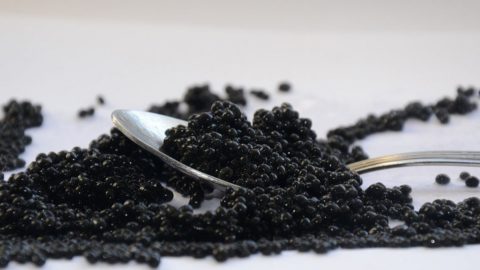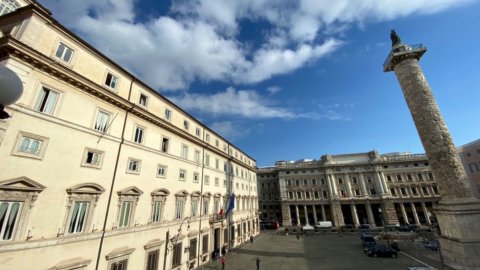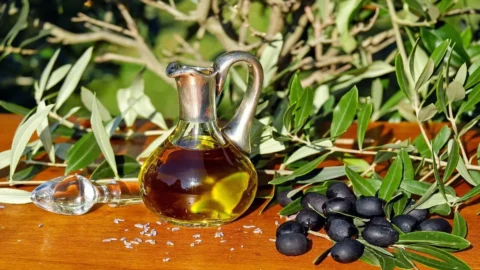It is known as the Russian black gold, let's not talk about oil, but about something much tastier for our palate: caviar, icon of gastronomic luxury, appetite all over the world for its luxuriant delicacy but also for its vaunted aphrodisiac powers, protagonist of novels and films, ("I'm bored without intelligent men, without the music I love and without women, who don't exist here in Yalta - Anton Chekhov wrote to Maksim Gorky, on February 15, 1900 - I boredom without caviar and without choucroute») a fundamental basis for skin beauty treatments in the most prestigious beauty centers worldwide. It is enough just to evoke it and we already feel transported to a world for the privileged excluded from the majority. It is certain that its most valuable quality, Almas Caviar, is truly a luxury that few can afford: it costs 300 dollars per kilo, it can be found at the Casa del Caviar in London, which sees it in a small 24-karat gold-plated container, at the modest sum of 24.000 euros. Yet once upon a time, in Russia, it was considered a food quite within everyone's reach, even the middle class ate it.
Its birth is due to the monks of the Kirillo-Belozersky monastery, founded at the end of the XNUMXth century on the shore of Lake Siverskoe. Tsar Alexei Michajlovich granted many benefits to the monastery to transform it into an impregnable bulwark in defense of the vital interests of Moscow in the north threatened by the expansionist ambitions of Sweden. Among these the concession of the lake. And the monks built the first Russian fish factory here, specializing in the trade of caviar, white fish, salmon, Russian sturgeon, beluga and sevruga and other types of fish. The sturgeon trade soon encompassed four lakes.
According to documents from the 6th century, another monastery that of the Trinity of St. Sergius in Sergiev Posad, about seventy kilometers north of Moscow, traded 300 Russian and sevruga sturgeons, 10 beluga sturgeons, 15 tons of black caviar, 500 barrels of Russian sturgeon , 200 backs of Russian sturgeon and XNUMX bellies of beluga sturgeon.
Trade flourished. But with the Northern War between Russia and Sweden (1700-1721) it Tsar Peter the Great imposed a monopoly to fatten the state's resources on fishing and the trade in fish products. In short, 80% of the black caviar was destined for export and the proceeds were used to finance the Russian naval fleet. We had to wait for the reign of Elizaveta Petrovna, daughter of Peter the Great, for the end of the monopoly which delivered the production of the Volga and the Astrakhan region into private hands. In the meantime, the fame of caviar had acquired worldwide dimensions. There was one exploitation so intensive that it almost came to extinction of the sturgeons from the Russian seas. It was decisive to introduce moratoriums to safeguard the species. Currently black caviar, extracted in nature, and not coming from farms, is completely absent from the market.
If it is no longer black gold for Russia, Caviar has meanwhile become pure gold for Italy. Because maybe not everyone knows that Italy has become the first producer of fine caviar in the world thanks to the intuition of Giovanni Tolettini, Brescian steel entrepreneur and Gino Ravagnan, an entrepreneur who had a factory for the construction of water treatment plants, reverse osmosis plants and oxygen production plants but who was also a great expert of fish farming to the point that the FAO had given him the task of drafting a document on the new fish farming criteria and of developing a program to increase productivity in lagoon waters.
The winning idea was by exploit the water heated by the Feralpi steelworks, coming from a very pure spring that flowed from the company's land in Calvisano in the province of Brescia and to convey them in large tanks thus obtaining an optimal habitat for some valuable fish species, including the White Sturgeon of the Pacific. This happened in the 70s: Agroittica Lombarda was born, today a very well-known Made in Italy brand to which the world's food and wine sanctuaries are reunited as it is the largest producer of fine caviar in the world, Calvisius, but it is also one of the largest producers of white sturgeon meat.
Sturgeon in Italy, a novelty? Not even for a dream why sturgeons here have always swum since ancient times in the waters of the Adriatic then going up the course of the rivers, first of all the Po but also the Adda, Ticino and Adige for spawning. Someone even ventures to say that caviar was born earlier in Italy than in Russia. What is certain is that in the treatise on cooking De honesta voluptate et valetudine, by Bartolomeo Sacchi known as humanist and gastronome Platina (about 1474) it is already mentioned. A legend even brings it up Leonardo Da Vinci who in 1491 would have had the idea of paying tribute to those precious eggs to Beatrice D'Este. And in Ferrara, a century later, Cristoforo di Messisbugo, author of a "Libro novo nel qual s'insegna a far d'ogni sorte di vivanda" (1557), reported the recipe for "caviaro to eat, fresh, or to save" but also to be eaten cooked. In short, caviar had a place of honor on the tables of the Italian Renaissance courts.
But as happened in Russia, indiscriminate fishing, river barriers and pollution have led to the complete extinction of this animal in our country. Which instead lives on in the farms of Agroittica Lombarda which today has come to cover almost 30% of the world demand for caviar with a turnover of over 2017 and a half million euros in 22
The "industrial dimensions" of the fine fish company are impressive. The breeding tanks extend over an area equivalent to sixty times the San Siro stadium, and the fish they produce 28 tons of precious eggs every year in an environment where the waters are very pure. The spring water is monitored twice a day to verify its absolute purity and compatibility with the needs of sturgeons. The production approach not only takes into account the food needs of the sturgeons, but also their ethological ones. The aquifer flows from the mountains through layers of gravel, the same natural substrate on which sturgeons have always preferred to feed and reproduce. Even the breeding basins are made up of natural gravel on which a complex ecosystem takes shape that supports small animals which represent the natural food of sturgeons, thus integrating their diet and increasing the sustainability of farming.
The company has also adopted rigorously scientific systems in the production processes: before the extraction of the caviar (around the twelfth year of age) it comes an ultrasound of the sturgeon was carried out to verify that the eggs were at the exact point of maturation. This obviously cannot happen with sea fishing, where the fish are caught without being able to check the state of maturation of the eggs. And as far as hygienic conditions are concerned, it is worth remembering that the caviar is extracted in "operating theatres" with overpressure air filtering, completely sterile and at a controlled temperature; with this system the caviar is not contaminated by any external agent.
For these reasons, the company has been awarded the Friend of the Sea recognition, because with its sustainable aquaculture technique it allows the birth of sturgeons in captivity and helps to safeguard the species, thus complying with the Washington Convention (Cites). The commitment of Agroittica Lombarda in the restocking of sturgeons in the waters of the PO also falls within this context.
The caviar thus obtained has an advantage compared to that traditionally caught at sea, it is less salty because it is freshly processed and therefore does not require excessive salting (no more than 3 percent), it is not subjected to sudden changes in temperature which can affect the taste and The aroma is processed, shipped and consumed as it is without undergoing pasteurization processes which harden the eggs by heating.
No wonder then if today in the first places among the importing countries of Italian Calvisius caviar, Russia, the former homeland of the black gold, is in first place, followed by France, USA, United Kingdom and Japan
The company is the main supplier of first class caviar for major airlines.
The production of Calvisius Caviar is divided into five products: Calvisius, Tradition, Prestige, Royal, Elite.
Among the tops Tradition is obtained from white sturgeon, a species native to the North American coasts of the Pacific Ocean. It is among the longest-lived sturgeons, capable of reaching one hundred years of age, weighing 800 kg and 6 m in length. Of a particularly delicate and elegant taste with buttery notes and aromas close to the world of pastry. It takes at least 12 years of waiting to obtain this caviar.
Calvisius Siberian is obtained from Siberian sturgeon. This fish produces medium-sized caviar (2.2-2.7 mm), requires a minimum of 7 years to produce caviar and is considered one of the earliest species. The caviar obtained from it has particular aromatic notes of dried fruit and a slightly iodized taste.
Beluga is large-sized caviar: in fact, its eggs easily exceed 3 millimeters in diameter. Extracted from the Huso huso sturgeon, it has a shiny and bright texture with a color ranging from pearl gray to dark gray, with the characteristic holes. The eggs have a creamy, pleasantly fat taste, with refined notes of the sea on the finish. It takes about 20 years to obtain this caviar, but the wait is amply repaid by a refined specialty of great elegance.
Finally, the company also produces the "Lingotto" created to overcome the thermal limit of caviar, normally intended for cold dishes, allowing chefs to use caviar even in hot preparations. Consisting of 100% pure caviar in whole grains, it is dehydrated through an innovative technique. The long rest in special molds and in particular conditions, concentrates the taste and above all the perfume. It is ready to be cut into thin strips to highlight the splendid filigree of whole grains or grated directly onto the dish to give it prestige and refinement (in 70 g packs).
Ordunque, if at the end of reading these notes someone may want to prepare a recipe based on Caviar, First&Food suggests it below:
Cook a white spaghetti al dente, cool it to room temperature almost tending to the cold then after lightly creaming it with the butter, after taking it from the cold fridge - as caviar must always be eaten - place a nice spoonful of 15 twenty grams of caviar on top. Add a sprinkling of chives and two drops of lemon. Et voilà, the dish is served! A minimal dish but at the same time excellent both for the flavor and for the chromatic values because it has the color of the pasta, the green of the chives and black or shaded amber depending on the type of caviar used. And an incredible taste explosion in the mouth.
By the way, so did Gualtiero Marchesi.





